What Types Of Fishing Waders Are Best For You?
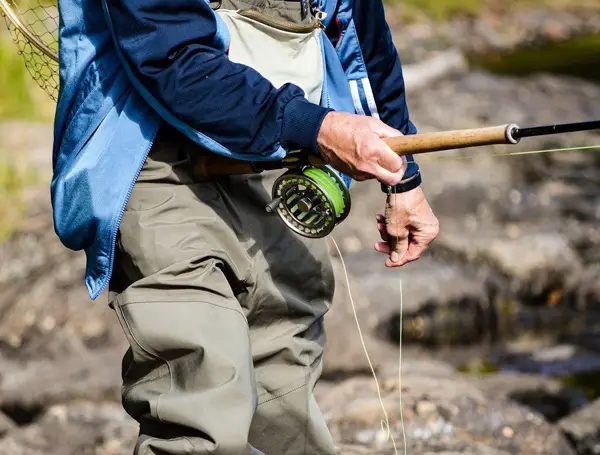
There are a lot of choices for fishing waders, which is great for the fisherman. Unfortunately, there are so many choices sometimes it becomes a little confusing. We hope this article provides the necessary information to help make an informed decision just for you.
So, with that in mind, let’s explore what fishing wader is best for you and look and some pro and cons of each type!
Types of Fishing Wader Construction.
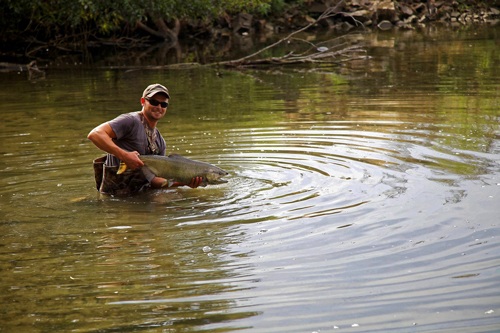
There are many different styles of wader construction to consider, so let’s look at the primary wader construction materials.
Click on 10 Best Fishing Waders for more information.
Wader Construction Materials:
1. Rubber Waders / PVC.
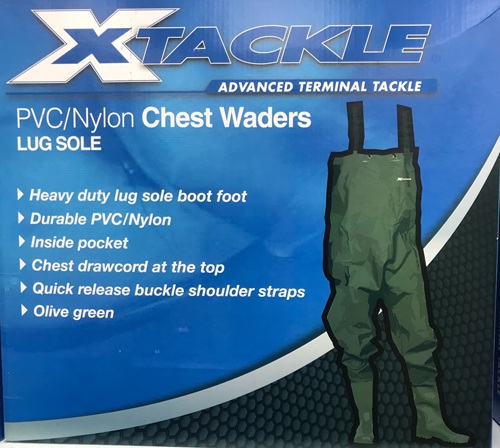
Ideal for the occasional wader angler on a budget. Relatively inexpensive and very tough. When punctured they are easy to patch.
The downside, and something to consider, they lack breathability and can become very hot. A comfortable day of fishing is a challenge when wearing rubber waders. They can get cold as well, but some thermals under some pants and you will be fishing more comfortably.
2. Canvas Waders.
With similar characteristics to rubber waders but with added toughness. The canvas wader is very durable and ideal for fishing in the rough areas where a puncture due to coarse fishing conditions just around the next turn in the river.
3. Neoprene Waders.
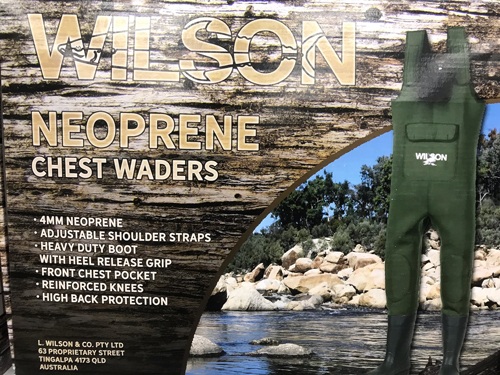
These waders are the cousin to wet suits since they utilize the same basic materials. The most popular choice for wade fishing with great insulation, flexibility, and punctures are easily patched. A very durable and comfortable wader.
For hot weather fishing, they are not ideal. They are better suited for moderate or colder environments. For cold weather fly fishing, these are my favorites.
I have used them kayak fishing and they are good. (Safely of course with a PFD, waist belt and in good weather.)
4. Breathable Waders.
The most comfortable wader with a unique ability to wick away sweat delivering the most comfort of all waders. A more expensive choice and creates a good fishing experience.
In very hot weather though, you still get hot though, but less than the rubber waders.
Types of Fishing Wader Designs.
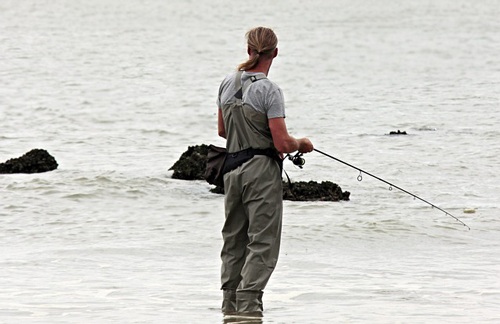
Now, let’s look at the various types of waders. There are three primary styles or designs, they are; chest waders, waist-high waders, and hip waders.
Chest Waders.
As the name implies, chest waders provide the most protection even covering the body up to the chest. This particular style of fishing wader is ideal for most waters and weather conditions. These style waders are typically more popular with the angler fishing rivers, lakes and streams providing the best option for deeper waters.
Chest waders provide very good insulation when the angler is properly attired for cold waters.
The most effective chest wader is manufactured in multiple layers which provide greater insulation and breathability. The heavier the fabric layer also may provide greater protection from snake bites whether on the bank or in the water.
One negative of the old chest waders was the thin straps that went over your shoulders. These would cut into your shoulders and put weight on your back when fly fishing for several hours. Anyone with back issues, this was a real problem. Luckily they have better shoulder straps that are wider and more padded today.
There are two primary styles of boots for chest waders, stockingfoot, and boot foot. Let us take a closer look and discover the best foot style for you.
1. Stockingfoot Style Wader.
Stockingfoot waders require the angler to purchase a separate wading boots or wading shoes. This may have several advantages such as more custom, comfortable fit which can extend the fishing day.
Also, since the wading boot is separate, the chest wader is more flexible and may pack better for a mobile angler. They also tend to excel if the angler plans on hiking from one fishing site to another.
For walking on stones and pebbles, the boots give more secure footing.
The downside is the extra expense and mucking around while the boots are put on. My friends use these sometimes fly fishing. It is frustrating getting out of the car and seeing fish rise at the lake feeding. I’m quickly ready to go, and my friends are still lacing up their boots.
2. Bootfoot Style Wader.
Bootfoot waders are inherently easier and quicker to use since they are built into the waders. They do not require bending over, slipping on a boot then tying the laces.
On the flip side, after a day fishing in extremely cold waters, one does not have to fumble untying the external boot, a nice feature the older one gets.
The boot foot also tends to provide better insulation due to more open-air spaces for circulation and also is not susceptible to debris lodging in the external shoe.
Definitely not as comfortable, but quicker to put on.
Waist High Waders.
Waist-high waders also called wading pants, are ideal for the angler who knows the waters and wants the most motion while fishing.
The wader is secured either by a belt or suspenders up to mid-thigh waters and is ideal for fly fishing in warmer weather. The waist-high wader can be purchased as either a stocking foot or boot foot wader.
Hip Waders.
Hip waders are the shortest choice for anglers and resemble chaps. Secured to your belt, they are ideal for fishing in a shallow, slower-moving stream. Adequate protection is provided up to the upper knee area.
They are very compact and may even come in handy for launching boats or probing shallows for bait. Hip waders come in both stocking foot and boot foot styles.
You could say they are a longer rubber boot.
One benefit is they allow more circulation, because they don’t cover the entire leg. However they are no good for deeper waters.
Safety while fishing or putting the boat in the water.
Although waders can bring much comfort and enjoyment to an angler, especially in freezing waters, they also can bring hidden dangers. If you fall into a deep pool of water, they may fill up quickly and become heavier. With the weight of the water, wearing waders can be very hard, if not impossible to get back into the boat.
To prevent panic and possible serious injury, one should practice a couple of times a controlled exit to waders. (Practice this on a hot day, with a friend in shallow water. With a PFD.) Although a wader full of water may not inherently lead to a less than optimal outcome, panic and indecision can contribute greatly to a serious accident.
Waders are not dangerous, especially when one is aware that waders full of water are manageable. Learning how to “skull”, or hand movement underwater for maximum propulsion and how to properly exit the waders will lead to a successful end to the fishing day.
Ideally never leave waders on in a boat. Take them off after you put the fishing boat in the water. They are hard to swim in and if you fall out accidentally, the boat can easily blow away faster than you can get to it on windy days. Of course you should have your life jacket on you, in the boat.
Suggested Cleaning and Storage of Waders.
Cleaning the Waders.
Most time the waders won’t need a clean, but if you are fishing in algae or muddy waters than a bit of care is always good.
The easiest way to clean waders after a long fishing trip is to dunk them in a tub. Place the waders in the bathtub with warm water then add some mild detergent soap.
Dunk the waders and give them a good going over with a soft cloth. Turn inside out, rinse and repeat the interior. Hang up to drip dry and you will be ready for the next fishing adventure!
Wader Storage.
The best way to store cleaned waders is to lay flat or hang dry. If lying flat place in a protected place, such as under the bed, and keep out of direct sunlight. Boot foot waders, when dry, can be packed with newspapers when to maintain their shape.
I generally just hang them up in the garage. Ideally hang them upside down, especially if you get a bit of water inside them, or if they are sweaty.
Suggested Wader Brands.
There are many manufactures of waders and some suggested reputable brands to consider are:
1. Orvis Premium Outdoor Gear.
2. Simms Fishing Gear.
3. Hornes waders.
4. Wilson.
5. Snowbee Waders.
If you are only fishing now and then, then the cheaper, Kmart and Walmart waders are fine. If you plan on doing some serious fly fishing or fishing, then consider a brand name.
We hope you enjoyed this article about fishing waders and the types, materials and designs. Thank you for reading and hopefully I will see you out fishing!
